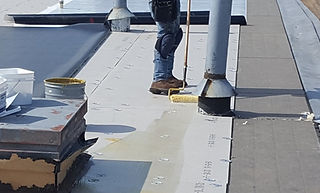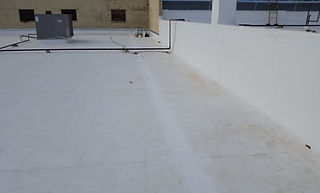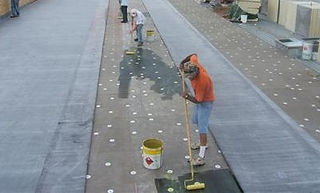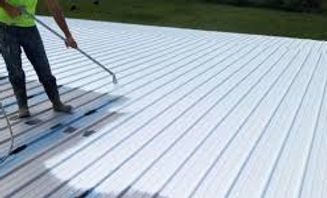
Roofing Membranes, System Types & Coatings
TPO Membrane

TPO short for Thermoplastic Polyolefin consists of a polymer base, polyester-reinforced fabric center scrim, and a thermoplastic oolyolefin compounded top ply. One of the fastest growing roofing systems around, white thermoplastic membrane offers reduced cooling costs and energy savings for facilities located in warm climates. A TPO membrane's reflective surface exceeds the EPA's Energy Star requirements and its white, tan and gray color options are listed with the Cool Roof Rating Council. This means that having a TPO roof on your building will keep the interior more comfortable on hot summer days while reducing your air conditioning bill. TPO is an ideal commercial roofing system that offers superior resistance to punctures and tears, algae growth, UV damage, the elements, and chemical exposure

TPO System: Mechanically Attached
Mechanically attached roof systems are by far the most common, they can be installed faster and at a lower cost. This system consists of insulation that is attached to the metal or wood roof deck with screws and plates. The TPO membrane is rolled out over the insulation and roof deck. Screws and plates are then installed at the membrane laps at different intervals depending on the manufacturer's specifications. Screws and plates are then covered by the overlapped roll of membrane. The seams of the membrane are hot-air welded together to form a very strong waterproof bond between sheets. All penetration and perimeters of the roof system are flashed and hot-air welded according to manufacturer's specifications.

TPO Fully Adhered
This system consists of insulation that is either adhered to the roof deck with adhesives, mechanically attached with screws and plates, or installed with a combination of adhesives and screws and plates. Adhesive is then applied to the insulation and the back of the TPO membrane. TPO membrane is then rolled out over the insulation. All seams of the TPO membrane are hot-air welded together to form a very strong waterproof bond between sheets. All penetration and perimeters of the roof system are flashed and hot-air welded according to manufacturer’s specifications. Fully adhered roof systems eliminate issues with the TPO membrane fluttering and are aesthetically pleasing choice for a roof that is in view of the public eye.
PVC Membrane

PVC short for polyvinyl chloride consists two layers of PVC roof material with polyester added in between the layers to act as a reinforcement. Additives are added to the PVC membrane to make the material more flexible, UV stable, and prevent curing. Although white is a common color since it reflects the sun’s heat, different colors are available. PVC membrane is Energy Star and LEED compliant, as well as listed with the Cool Roof Rating Council. Reflecting nearly 90% of the sun's heat, PVC lowers energy cost substantially, especially in high-heat areas such as the southeastern United States. PVC roofing membranes offer an impressive set of advantages. Among the most notable benefits are strength, durability, resistance to moisture, wind, fire and chemicals. Also, PVC is Eco-friendly and can be fully recycled after its service life.

PVC System: Mechanically Attached
Mechanically attached roofs are the most common roof systems installed, dominating around 80% of the market. They can be installed faster and at a lower cost. On top of most building is a metal deck, a layer of insulation, and then the roof. Insulation is fastened to the metal deck using screws and plates. PVC membrane is then rolled out over the insulation and then more screws and plates are used to mechanically attach the membrane through the PVC and insulation and into the metal deck below. A watertight seal is then created by heat-welding the membranes together with a hot-air welder. This seal forms a very strong waterproof bond between sheets.

PVC System: Fully Adhered
This system also consists of insulation that is fastened into the metal deck using screws and plates. Once the insulation has been thoroughly fastened down, the roofing membrane is rolled out. Then, bonding adhesive (or glue) is applied to both the rigid insulation and the membrane. The membrane is then rolled in for a tight bond. All membrane laps are heat-welded together with a hot-air welder to form a very strong waterproof bond between sheets. Since fully adhered PVC roofing systems are bonded to the insulation they lay flat to the roof and are aesthetically pleasing, having the least amount of membrane fluttering. Fully adhered roof systems are great for installation on tall building and in high-wind areas
EPDM Membrane

EPDM short for Ethylene Propylene Diene Monomer is a synthetic rubber consisting of oil and natural gas. Choices include black or white EPDM, and roof systems include mechanically attached, fully adhered, and ballasted. EPDM membrane is highly resistant to UV rays, high winds, hail, and extreme hot and cold temperatures. Due to EPDM'S elastic characteristic it is able to withstand structural expansion and contraction. EPDM has been installed on roofs since the mid 1970's and has an excellent track record supported by actual field installations and various laboratory studies.
Modified Bitumen Membrane

Modified bitumen or “mod bit” is mainly made up of asphalt modified with atactic polypropylene (APP), styrene butadiene styrene (SBS), synthetic rubber or other ingredients that enhance the physical properties of the asphalt. SBS and APP are the most common bitumen modifiers. Modified Bitumen Roof System are typically installed with 1-3 ply’s, and come in many different colors. There are several ways to install a modified bitumen roof, but the four most common methods are self adhered, cold applied, heat weld, and torch down. Modified Bitumen is very resistant to physical damage, and has a high fire, wind, and hail damage rating. Modified Bitumen was developed in Europe in the 1970s and the United States started developing modified bitumen compounds in the late 1970s and early 1980s.

EPDM System: Mechanically Attached
An EPDM mechanically attached roof system can be installed on buildings where the roof decking provides enough pull-out resistance for the appropriate attached fasteners. Mechanically attached systems consist of sheets of insulation that are attached to the metal or wood roof deck with screws and plates. EPDM membrane is then rolled out over the insulation. All overlapping EPDM membrane is then fastened at laps with screws and plates at different intervals depending on the manufacturer’s specifications. Screws and plates are then covered by the overlapped roll of membrane. The lap of the EPDM membrane is then cleaned, primed, and then stripped in with EPDM seam tape. All penetration and perimeters of the roof system are flashed according to manufacturer’s specifications.

EPDM System: Fully Adhered
This system consists of insulation that is either adhered to the roof deck with adhesives, mechanically attached with screws and plates, or installed with a combination of adhesives and screws and plates. Adhesive is then applied to the insulation and the back of the EPDM membrane. EPDM membrane is then rolled out over the insulation. All seams of the EPDM membrane are then cleaned, primed, and then stripped in with EPDM seam tape. All penetration and perimeters of the roof system are flashed according to manufacturer’s specifications. Fully adhered roof systems eliminate issues with the EPDM membrane fluttering, and are aesthetically pleasing choice for a roof that is in view of the public eye.

Modified Bitumen System: Self Adhered
First insulation is mechanically attached to the metal or wood roof deck with screws and plates. Then a self adhering base ply of membrane is rolled out over the insulation and a release film on the back side of the membrane is removed so the base ply self adheres to the insulation. Following the base layer is either a self adhering granulated cap sheet or a self adhering mid ply depending on what the particular job calls for. Self adhering modified bitumen roof systems offer many advantages: no torches, no fumes, no hot asphalt, and no mess. Making the application much cleaner and faster. One ply modified bitumen roof systems have not shown any long term success. Ability Roofing, LLC will not install any one ply modified bitumen roof systems.

Modified Bitumen System: Cold Applied
As with all other low-sloped roofing systems first insulation is mechanically attached to the metal or wood roof deck with screws and plates. Then cold liquid adhesive is applied over the insulation and either felts or a modified bitumen base ply is rolled out over the liquid adhesive, with liquid adhesive also applied to the back of the ply. Another layer of cold liquid adhesive is rolled out over the base ply and onto the back of the second ply. Usually a two to four ply system consisting of a modified bitumen base and cap plies are installed, with additional plies for added strength if needed. The additional plies are either one or more built-up roofing (BUR) felts or one or more modified bitumen sheets depending on what the strength, and the performance objectives of the job call for.

Modified Bitumen System: Hot Applied
Insulation is mechanically attached to the metal or wood roof deck using screws and plates. A hot kettle of asphalt is melted to 400 degrees and spread out onto the insulation. Once the layer of asphalt is spread out over the insulation a base ply of roofing felt or modified bitumen is rolled out over the asphalt. All following layers of roofing felts and modified bitumen are installed in the same way with a cap sheet being the top layer. All seams are hot air welded with a robotic welder.

Modified Bitumen System: Torched Down
Insulation is mechanically attached to the metal or wood roof deck using screws and plates. Two sheets of modified bitumen are rolled out over a flat roof surface with their edges overlapping. A propane torch is then used to move down the sheet heating the overlapped seams to the point that the material liquefies. The weight of the material itself secures the bond, or a weighted roller is used to bond the two sheets together. Additional plies of roofing felts or modified bitumen are added to the base sheets. Installing torch down roofs requires very expensive insurance premiums, if they will insure the roofing project at all. Ability Roofing, LLC does not install torch down modified bitumen roofs due to the fire and safety risks associated. With propane torches reaching temperatures between 2,100 and 3,000 degrees Fahrenheit we recommend alternative modified bitumen roof installation methods.
Coatings
The most important factors of any roof coating application is proper preparation of the roof and following installation details. Roof coatings are made to protect and extend the service life of existing roof systems such as single-ply, modified bitumen, metal, and built up roof systems (BUR). Coatings protect roof membranes from ultraviolet rays, general weathering, and provide a watertight layer on an existing roof. Roof coatings are thicker than standard paint, have a higher solids content, and often applied in several coatings with a sprayer, roller, or brush. Most roof coatings are extremely elastic due to the high-quality resins that are introduced during manufacturing allowing the coating to expand and contract with swings in temperature. Coatings can enhance reflectivity, and lessen a building’s cooling load. Many flat roofs puddle or pond in some areas. Most roof coatings are not covered under manufacturers warranties for ponding water, and can fail pre-maturely if installed in areas that tend to have standing water.
Serious consideration should be given the coating being selected. A few manufacturers will warranty their coatings to included ponding water. Most manufacturers for acrylic roof coatings will not warranty roofs for ponding water, however some silicone and polyurethane roof coatings manufacturers will. There are several manufacturers and types of roof coatings some better than others. The most common types of roof coatings are acrylic, silicone, polyurethane, and asphalt.

Acrylics
Acrylics is general have many uses and are used for a wide range of applications, but certain types of acrylic formulations have been engineered that are specifically designed for roof coatings. Acrylic coatings are water based and usually white in color, but color can be added. Acrylic coatings resist the effects of UV degradation from the sun, are very elastic in nature, and can withstand foot traffic associated with servicing equipment that is placed on the roof.
Silicone
Silicone roof coatings can stand up to the harshest of UV rays without degrading and are superior to acrylic coatings. Unlike water based acrylic coatings that can deteriorate and separate in standing water, silicone roof coatings become harder in reaction to water. Available in a variety of colors with white being the most popular due to its reflectivity silicone roof coatings can be a good choice to extend the service life of a roof.

Polyurethane
Polyurethane roof coatings key properties are being flexible, tough, and able to withstand foot traffic and impacts from hail or workers on a roof more than any other coating. Most polyurethane roof coatings tend to be white in color and can help save money on cooling costs. There are two main types of polyurethane roof coatings aromatic and aliphatic and both have their proper uses. Aromatic polyurethane roof coatings are usually applied as a base coat, are less expensive, bond to various substrates, but are not very UV resistant. Aliphatic polyurethane roof coatings are more expensive, have exceptional UV resistance, resist ponding water more than acrylic coating, hold color well, stay clean, and offer superior bonding strength. Although more expensive than other coatings a Polyurethane roof coating system with an aromatic base coat and an aliphatic top coat can be a very good option when trying to decide on a roof coating type.

Asphalt
Asphalt roof coatings are either emulsions or solvent-based, and do best when applied to other asphalt substrates. Asphalt roof coatings can be either black or fibered with aluminum. There are many different types of asphalt roof coatings. Some are used to restore weathered or aged asphalt BUR systems and are less expensive, while others contain synthetic rubber polymers, and reinforcing fibers that increase elasticity, and flexibility, but are more expensive.




